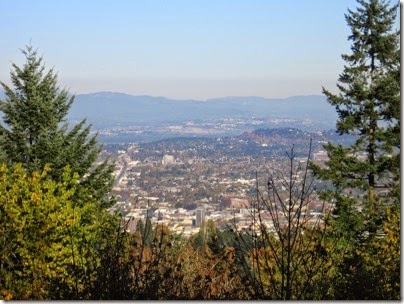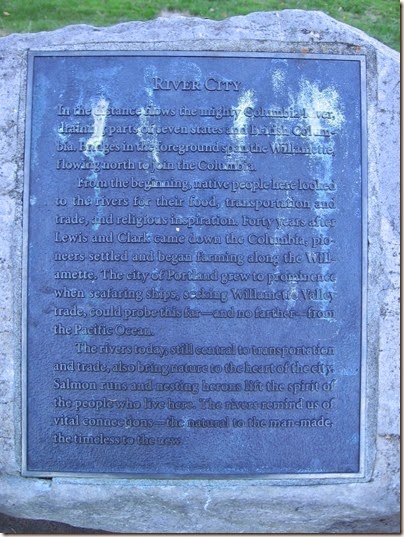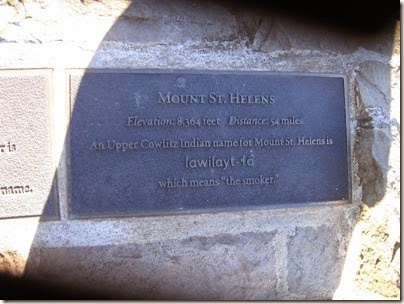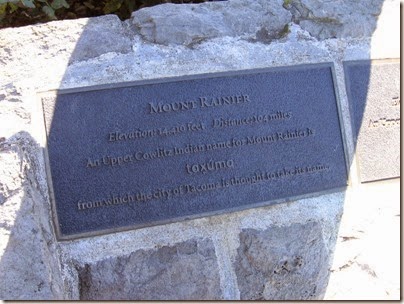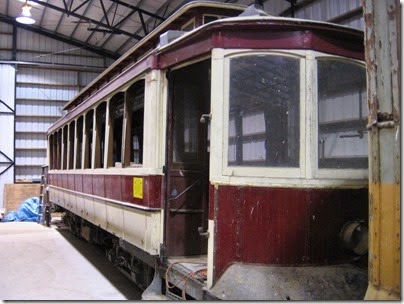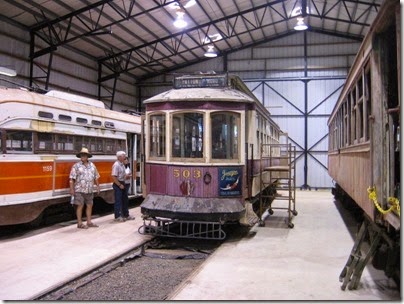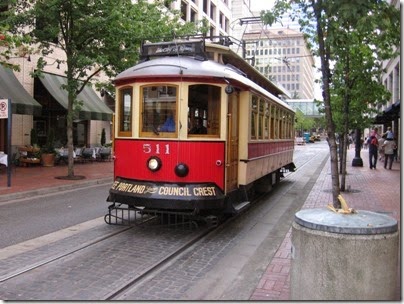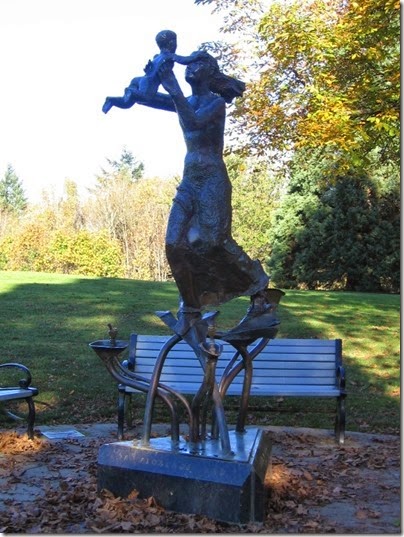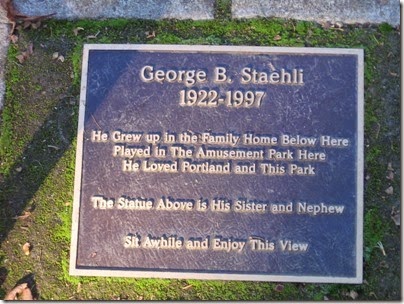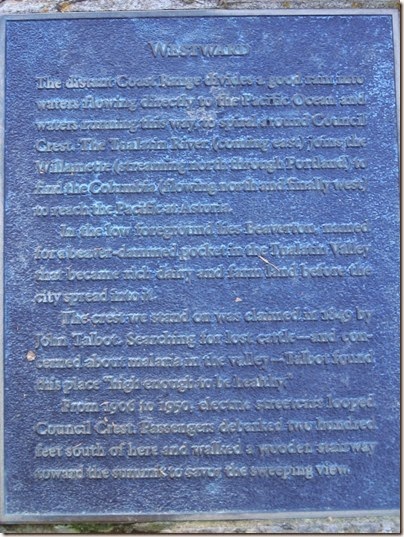I originally posted the Willamette Shore Trolley page on my old website as a PORTLAND PLACES page on October 10, 2008.
(NOTE: This website is NOT affiliated with the Trolley; visit www.oerhs.org/wst/ for current info)

Willamette Shore Trolley in Lake Oswego on April 26, 2008
The Willamette Shore Trolley is a tourist trolley operating along the west side of the Willamette River between Portland and Lake Oswego from late spring to early fall. The line is operated with a historic Portland streetcar by the Oregon Electric Railway Historical Society to keep it in active use for future conversion to mass transit use.
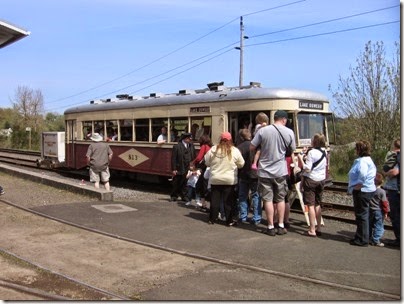
Willamette Shore Trolley in Lake Oswego on April 26, 2008
Construction of the rail line that is now the route of the Willamette Shore Trolley began in 1885 by the Portland and Willamette Valley Railroad, a three-foot-gauge line running from Jefferson Street in Portland through Oswego (as Lake Oswego was known until 1960), Tualatin, Sherwood and Newberg to Dundee and eventually McMinnville. The P&WV began operation in July, 1887. It was purchased by the Southern Pacific Railroad around 1890 and was converted to standard 4'-8.5" gauge in the early 1890s, though it maintained a third rail for dual gauge until 1895. In 1910 a connection was opened from Oswego across the Willamette River to Milwaukie.
Southern Pacific began electric interurban service on the line on January 17, 1914 in order to compete with the Oregon Electric Railway, which had been providing Interurban service from Portland to Salem since 1907 and had extended to Albany and Eugene in 1912. Initially operating under the Portland, Eugene & Eastern Railroad name, the name was changed to Southern Pacific on July 1, 1915. In any case, the public referred to the service as the "Red Electrics" after the color of the equipment. Service to Corvallis began June 17, 1917 with a running time of 3 hours 15 minutes. In 1920, 64 Red Electrics ran between Portland and Oswego every day, but that would be the peak. New roads brought buses that chipped away at the interurban business until the service ended on October 5, 1929. Some of the Red Electric interurban cars went to Los Angeles, where they operated as "Red Cars" on the famous Pacific Electric.

Willamette Shore Trolley in Lake Oswego on April 26, 2008
Though passenger service had ended, steam-powered freight service continued on the line, giving way to diesels in the 1950s. In 1983, freight service from Lake Oswego to Portland ended. The Interstate Commerce Commission gave Southern Pacific permission to abandon that part of the line in August, 1984, but once abandoned the right-of-way would revert to the property owners along the line. In November, the non-profit Portland Friends of the Willamette River Greenway were asked to assist seven government entities to acquire the line for future mass transit use.

Willamette Shore Trolley in Lake Oswego on August 31, 2008
In order to keep the line from reverting to the property owners, it had to maintain an active rail use. The Oregon Electric Railway Historical Society operated a trolley on the line from September to December, 1987 to determine its feasibility. The governmental entities formed a consortium and purchased the six-mile Jefferson Street Line from Southern Pacific in June, 1988. The City of Lake Oswego leases the Jefferson Street Rail Line from the consortium, which includes the City of Lake Oswego, the City of Portland, Clackamas County, Multnomah County and Metro. Trolley service began in July, 1990, with the San Antonio Museum of Art's 1913 American Car Co. streetcar #300, originally from San Antonio, Texas, operated by Paul Class and Gales Creek Enterprises.
In 1995, the Oregon Electric Railway Historical Society took over the operation of the Willamette Shore Trolley, using double-deck trolley #48 from Blackpool, England.
Trolley #300 left the line and was was eventually leased by the Astoria Riverfront Trolley Association in November, 1998. Trolley #300 has operated in Astoria since 1999 and was purchased from the San Antonio Museum of Art by the Astoria Riverfront Trolley Association in 2005.
After the completion of a restoration in 1998, original 1932 Portland "Broadway Car" #813 joined double-decker #48 on the Willamette Shore Trolley line, and the pair shared the workload.

Willamette Shore Trolley in Lake Oswego on August 31, 2008
Double-decker #48 was taken out of Willamette Shore Trolley service in August 2004 due to the rigors the popular service placed on the antique streetcar. It made a final benefit run from Lake Oswego to Portland on the morning of May 6, 2006, and was subsequently was loaded onto a truck and moved to the Oregon Electric Railway Museum site at Antique Powerland in Brooks, Oregon. Today, #813 is the only trolley assigned to the Willamette Shore Trolley line.

Willamette Shore Trolley in Lake Oswego on August 31, 2008
Car #813 is one of 15 Master Units built by J. G. Brill and Company in 1932 for the Portland Traction Company.

Willamette Shore Trolley in Lake Oswego on April 26, 2008
In Portland, these cars were called "Broadway Cars," after the line they were originally assigned to. They were the last new streetcars purchased for service in Portland (until the modern MAX light rail of the 1980s).

Aboard the Willamette Shore Trolley on April 26, 2008
When Portland's narrow gauge streetcar lines were shut down in 1950, #813 was one of two Broadway cars to be changed to standard gauge for use on the interurban lines, which lasted until 1958. On the Interurban lines, #813 was renumbered to #4012.

Aboard the Willamette Shore Trolley on April 26, 2008
In 1959, the car was sold to the OERHS, who put it on display at Oaks Amusement Park until the Glenwood Trolley Park was open.
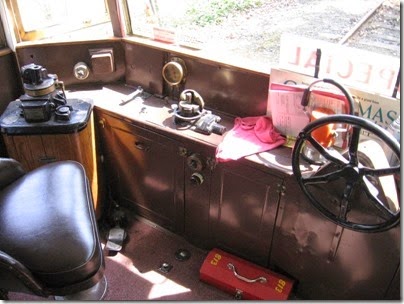
Willamette Shore Trolley Controls on April 26, 2008
In the 1990s, the car was given a full restoration, which was completed in 1998, restoring the car to its original number and paint scheme, though it retains its standard gauge trucks.
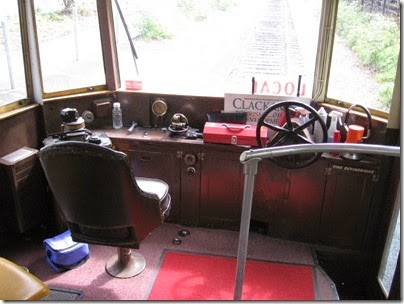
Willamette Shore Trolley Controls on August 31, 2008
When the OERHS moved to Brooks, #813 was moved to the Willamette Shore Trolley, though it made at least one trip back to Brooks, for the 2000 Great Oregon Steam-Up.
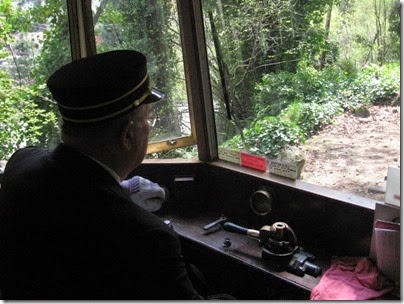
Willamette Shore Trolley Operator on April 26, 2008
Willamette Shore Trolley service was suspended in 2010 due to repairs needed by #813. It was moved to Brooks in 2012 and was replaced by one of the Portland Vintage Trolley “Council Crest Car” replicas in 2014.
Links to Historical Photographs:
#813 in service in 1949 (Dave’s Electric Railroads)
#4012 in service in Portland (Dave’s Electric Railroads)

Willamette Shore Trolley Sign in Lake Oswego on April 26, 2008
The south end of the Willamette Shore Trolley line is in downtown Lake Oswego at 311 North State Street.

Willamette Shore Trolley Sign in Lake Oswego on April 26, 2008
There is a parking lot here specifically for trolley passengers, accessed from Foothills Road, and a small building housing a gift shop where tickets are sold.
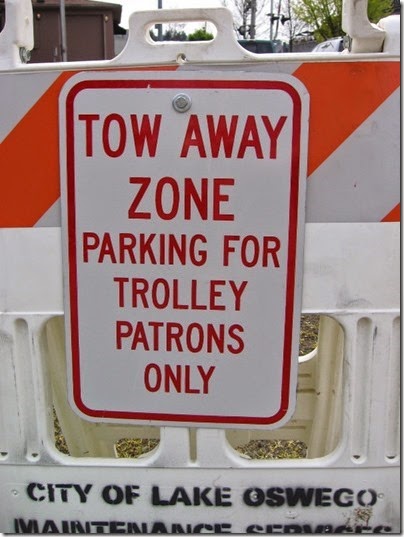
Willamette Shore Trolley Sign in Lake Oswego on April 26, 2008

Willamette Shore Trolley in Lake Oswego on August 31, 2008
The trolley itself boards just to the north, about a half-mile south of the Jefferson Street line's original terminus.

Willamette Shore Trolley in Lake Oswego on August 31, 2008

Willamette Shore Trolley in Lake Oswego on August 31, 2008

Willamette Shore Trolley in Lake Oswego on August 31, 2008

Willamette Shore Trolley in Lake Oswego on August 31, 2008

Willamette Shore Trolley in Lake Oswego on April 26, 2008
Just to the north of the end of the line is the Willamette Shore Trolley carbarn. The carbarn was built with public funding and was dedicated on September 9, 1998.
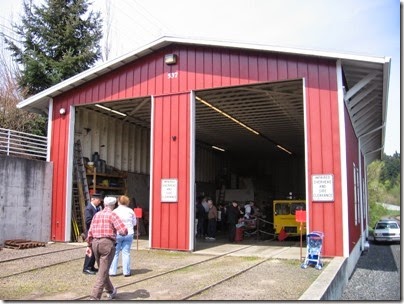
Willamette Shore Trolley Carbarn on April 26, 2008
It was built with 2 tracks in order to house two trolleys and is tall enough to clear double-deck trolley #48 when it operated on this line.

Willamette Shore Trolley Carbarn on April 26, 2008
The carbarn is equipped with an inspection pit for easy access to the underside of trolley cars for repairs.

Sucker Creek Jazz Band on April 26, 2008
The carbarn is pictured here during Neighbor Appreciation Day on April 26, 2008 when it was open to the public and featured live music by the Sucker Creek Jazz Band.

Speeder in Willamette Shore Trolley Carbarn on April 26, 2008
Pictured inside the carbarn over the inspection pit is this fully-enclosed motorized speeder and trailer, which is used by the volunteers of the Willamette Shore Trolley to travel over the line to inspect the track and perform maintenance and repairs.
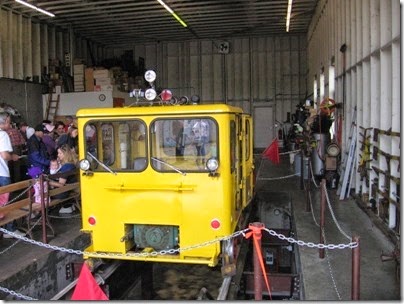
Speeder in Willamette Shore Trolley Carbarn on April 26, 2008

Speeder in Willamette Shore Trolley Carbarn on April 26, 2008

View from the Willamette Shore Trolley on April 26, 2008
The rail line from Lake Oswego west to Tualatin and east to Milwaukie still sees freight service, and is still owned by the Union Pacific Railroad, which acquired Southern Pacific in 1996.
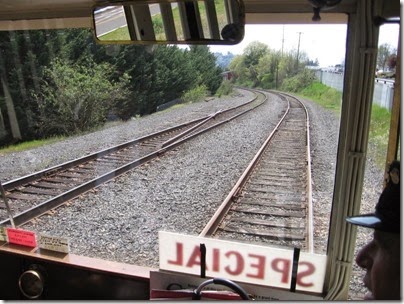
View from the Willamette Shore Trolley on April 26, 2008
The line has been leased to the Portland & Western Railroad since 1995.
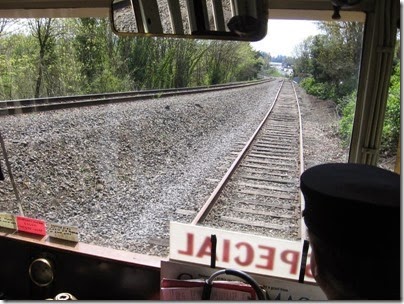
View from the Willamette Shore Trolley on April 26, 2008
The Jefferson Street Line originally separated from the still-active freight line about a half-mile north of Lake Oswego.

View from the Willamette Shore Trolley on April 26, 2008
Since trolley service started, the line has been extended to reach the downtown area with a track that parallels the freight line for the half-mile.

View from the Willamette Shore Trolley on April 26, 2008
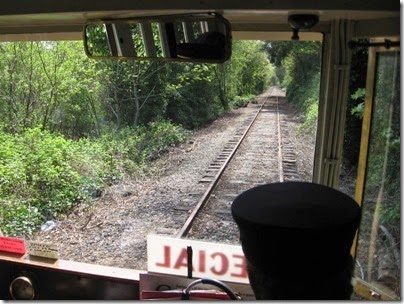
View from the Willamette Shore Trolley on April 26, 2008

UFO House on the Willamette Shore Trolley line, August 31, 2008
Just south of the entrance to the Elk Rock Tunnel, this unusual house is visible on the hillside above the tracks on the west side. The Willamette Shore Trolley volunteers describe this house as a "Flying Saucer" for children aboard the trolley, and the trolley sometimes stops briefly to let passengers get a good look.
At this point the trolley enters the Elk Rock Tunnel. Originally the railroad went around Elk Rock on the 1400-foot wooden Elk Rock Trestle. Rock slides off of Elk Rock were fairly common, and rocks would sometimes strike passing trains. After a rock crashed through a coach and struck Mrs. Ella Newlands, wife of the president of the Oswego Cement Company, the decision was made to tunnel under Elk Rock. The 1,396-foot S-shaped Elk Rock Tunnel opened on December 5, 1921. I don't have any photos of the tunnel, but it can be seen in some of the videos further down this page.

Wig-wag signal at Riverwood Road on August 19, 2007
The railroad crossing at Riverwood Road features a vintage Magnetic Flagman "wig-wag" crossing signal, a common grade crossing signal before the modern crossbuck became a standard and flashing lights and gates were mandated.

Wig-wag signal at Riverwood Road on August 19, 2007
These signals were first made in 1910 and were installed through the late 1940s. The single red light swings back and forth when a train is near, simulating the motion that a flagman would make with his flag or lantern. This Model 3 lower-quadrant signal, made by the Magnetic Signal Company of Los Angeles, California, is one of only a handful remaining in active use in Oregon, which has more than most other states.
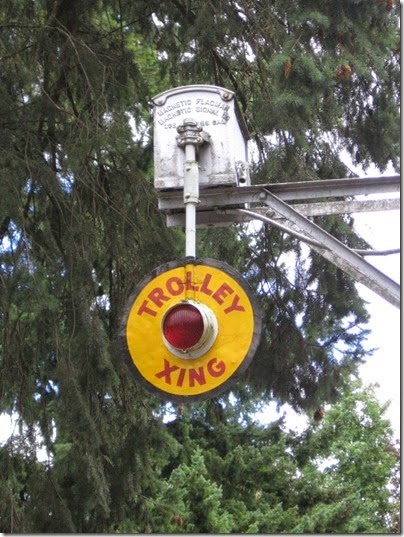
Wig-wag signal at Riverwood Road on August 19, 2007
There were three of these signals on the Willamette Shore Trolley line, though now only two remain. They have uniquely-painted banners seen nowhere else, proclaiming a "Trolley Xing." The Oregon Department of Transportation has made an effort to remove all remaining wig-wags in the state, but the Willamette Shore Trolley wig-wags don't seem to be affected.
This video shows the southbound Willamette Shore Trolley at the Riverwood Road wig-wag.

Willamette Shore Trolley at Riverwood Road on August 19, 2007
The trolley will stop at Riverwood Road if passengers request it.

Willamette Shore Trolley at Riverwood Road on August 19, 2007
Shortly after passing Riverwood Road, the trolley crosses over some timber trestles that give a view of the Willamette River, including the 686-foot-long Riverwood Trestle, and then through Powers Marine Park.

Willamette Shore Trolley at Riverwood Road on August 19, 2007
This video from the Willamette Shore Trolley's Neighbor Appreciation Day on April 26, 2008 includes a ride on the southern part of the line from Lake Oswego through the Elk Rock Tunnel to Riverwood Road.
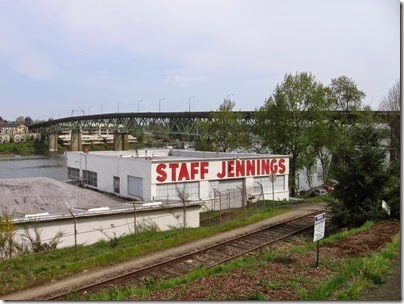
Sellwood Bridge on April 26, 2008
After passing through Powers Marine Park, the trolley passes under the west end of the Sellwood Bridge, the southernmost Willamette River Bridge that is technically within Portland. Sellwood, on the east side of the river, was annexed into Portland in 1893. The Sellwood Bridge is a four-span continuous-truss bridge. It opened on December 15, 1925, and is one of only three pre-1941 continuous-truss bridges in Oregon. It was designed by Gustav Lindenthal, who also designed Portland's Burnside Bridge and Ross Island Bridge and New York City's Hell Gate Bridge and Queensboro Bridge. The total length of the bridge is 1,971 feet. The four main spans form a 1,092-foot continuous Warren deck truss. The two center spans are each 300 feet long, while the other two are 246 feet long. Steel girders from the first Burnside Bridge, built in 1894, were used in the approaches of the Sellwood Bridge. The steel was fabricated by the Judson Manufacturing Company and the bridge was constructed by Gilpin Construction Company of Portland. The bridge was built at a cost of $541,000.

Sellwood Bridge on April 26, 2008
The two-lane bridge features a 24-foot roadway with a single 4'-3" sidewalk on the north side. It has 75 feet of vertical clearance. It is the busiest two-lane bridge in Oregon. Cracks discovered in the approaches in January 2004 led to the weight limit being lowered to 10 tons. Construction of a new Sellwood Bridge began in December 2011, with completion scheduled for January 2016. The old Sellwood Bridge will then be demolished.
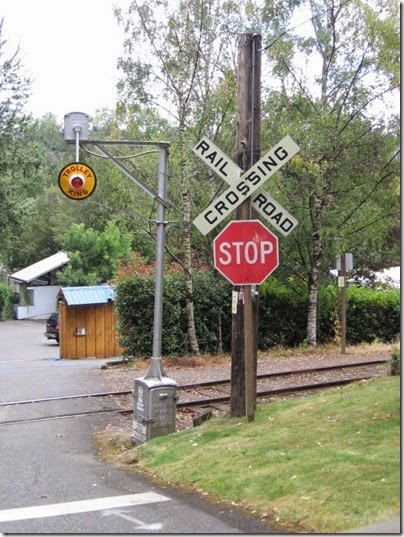
Wig-wag signal at Macadam Bay on August 19, 2007
North of the Sellwood Bridge is this railroad crossing leading to the Macadam Bay Yacht Club and Butterfly Park.

Wig-wag signal at Macadam Bay on August 19, 2007
At this crossing another Magnetic Flagman "wig-wag" stands guard with its unique banner.

Wig-wag signal at Macadam Bay on August 19, 2007
This wig-wag is plainly visible from SW Macadam Avenue/Oregon Highway 43.

Wig-wag signal at Nebraska Street on August 19, 2007
This Magnetic Flagman "wig-wag" stood at the Nebraska Street crossing near the entrance to Willamette Park.

Wig-wag signal at Nebraska Street on August 19, 2007
This signal was struck by a vehicle in early 2008 and had to be removed. A member of the trolley crew must now manually flag the crossing.

Wig-wag signal at Nebraska Street on August 19, 2007
The banner shaft of this crossing was decorated with the text of Proverbs 15:3, "The eyes of the Lord are in every place beholding the evil and the good." in tiny lettering.

Wig-wag signal at Nebraska Street on August 19, 2007
The banner was still painted in an earlier "Stop for Trolley" paint scheme.

Willamette Shore Trolley at Nebraska Street on August 19, 2007

Willamette Shore Trolley at Nebraska Street on August 19, 2007

Willamette Shore Trolley at Nebraska Street on August 19, 2007

Willamette Shore Trolley in Portland on August 31, 2008
The Willamette Shore Trolley's north terminus was originally at Riverplace, just south of downtown Portland.

Willamette Shore Trolley in Portland on August 31, 2008
In May 2004 it was cut back to SW Bancroft Street & Moody Avenue and the Bancroft Street Station become the north end of the line.

Willamette Shore Trolley in Portland on August 31, 2008
This video from August 31, 2008 shows segments of the entire Willamette Shore Trolley line.

Portland Streetcar #004 in South Waterfront on August 19, 2007
The opening of Portland Streetcar's extension to Riverplace in 2005 required the cutback of the Willamette Shore Trolley line. The streetcar line was extended again into the South Waterfront, opening on August 17, 2007, running down SW Moody Avenue where the Willamette Shore Trolley once ran to SW Lowell Street, just one block north of the Bancroft Street Station.

Portland Streetcar #004 in South Waterfront on August 19, 2007
Related Links:
Willamette Shore Trolley
City of Lake Oswego's Willamette Shore Trolley Page
world.nycsubway.org's Willamette Shore Trolley Page
The Red Electrics at PdxHistory.com



